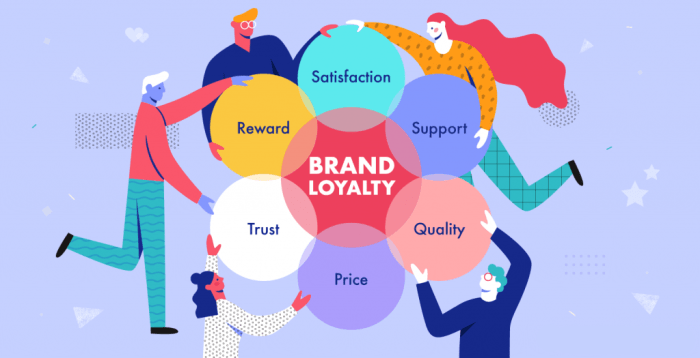Building a Brand Loyalty Program opens the door to a world where customers are not just buyers, they become loyal fans. Dive into this journey of loyalty, rewards, and success in the marketing realm.
In this guide, we will explore the different aspects of creating and maintaining a successful brand loyalty program to keep your customers coming back for more.
Introduction to Brand Loyalty Programs
Brand loyalty programs are strategic marketing initiatives designed to cultivate and maintain a strong connection between a company and its customers. These programs offer incentives, rewards, and exclusive benefits to encourage repeat business and foster a sense of loyalty among consumers.
Importance of Brand Loyalty Programs
Brand loyalty programs play a crucial role in marketing by helping businesses retain customers in a competitive marketplace. By offering rewards and incentives for repeat purchases, companies can create a loyal customer base that is more likely to choose their brand over competitors.
- Increased Customer Retention: Brand loyalty programs help businesses retain existing customers by providing incentives for repeat purchases, leading to long-term relationships.
- Enhanced Customer Engagement: By offering exclusive rewards and benefits, brand loyalty programs engage customers and encourage them to interact more with the brand.
- Boosted Sales and Revenue: Loyal customers are more likely to make frequent purchases, resulting in increased sales and revenue for the company.
Types of Brand Loyalty Programs
Brand loyalty programs come in various forms, each tailored to engage and retain customers in different ways. Let’s explore the different types of brand loyalty programs and their unique features.
Points-Based Loyalty Programs
Points-based loyalty programs are one of the most common types, where customers earn points for purchases or other actions. These points can be redeemed for rewards or discounts, incentivizing repeat purchases. Examples include Starbucks Rewards and Sephora Beauty Insider.
Tiered Loyalty Programs
Tiered loyalty programs offer different levels of rewards based on customer spending or engagement. As customers move up tiers, they unlock exclusive benefits and perks. A well-known example is the Marriott Bonvoy program, with Silver, Gold, and Platinum tiers.
Paid Loyalty Programs
Paid loyalty programs require customers to pay a fee to access premium benefits and rewards. While it may seem counterintuitive, some customers are willing to invest in these programs for exclusive perks. Amazon Prime is a prime example, offering fast shipping, streaming services, and more for a subscription fee.
Designing a Brand Loyalty Program
When it comes to designing a brand loyalty program, there are several key elements to consider to ensure its success. From setting achievable goals to creating a program from scratch, each step plays a crucial role in engaging customers and fostering brand loyalty.
Key Elements to Consider
- Understand Your Target Audience: Identify who your loyal customers are and what motivates them to stay loyal to your brand.
- Rewards Structure: Determine what type of rewards will incentivize customers to participate in the program and keep coming back.
- Communication Strategy: Develop a clear communication plan to inform customers about the program and keep them engaged.
- Data Analysis: Utilize data analytics to track customer behavior, preferences, and program effectiveness for continuous improvement.
Setting Achievable Goals
- Define Objectives: Clearly Artikel what you aim to achieve with the loyalty program, whether it’s increasing customer retention, boosting sales, or enhancing brand advocacy.
- SMART Goals: Ensure your goals are Specific, Measurable, Achievable, Relevant, and Time-bound to track progress effectively.
- Benchmarking: Compare your goals with industry standards and past performance to set realistic targets for your brand loyalty program.
Creating a Program from Scratch
- Research and Planning: Conduct market research to understand customer preferences and behaviors, then create a detailed plan outlining the program structure and rewards.
- Implementation: Develop the program using suitable technology platforms, integrate with existing systems, and test before launch to ensure smooth operation.
- Promotion: Roll out the program with a strong marketing campaign to generate awareness and excitement among customers, encouraging them to participate.
Implementing a Brand Loyalty Program: Building A Brand Loyalty Program

Implementing a brand loyalty program is crucial for businesses looking to retain customers and drive repeat purchases. It involves launching the program effectively, promoting it to existing and potential customers, and engaging them to encourage participation.
Launching a Brand Loyalty Program Effectively
To launch a brand loyalty program effectively, it’s essential to clearly define the objectives of the program, set achievable goals, and ensure it aligns with the brand’s values and customer needs. Additionally, businesses should invest in a user-friendly platform for seamless enrollment and participation.
- Define clear objectives and goals for the loyalty program
- Ensure alignment with brand values and customer expectations
- Invest in a user-friendly platform for easy enrollment and participation
- Communicate the benefits of the program clearly to customers
Promoting a Brand Loyalty Program
Promoting a brand loyalty program to existing and potential customers requires a multi-channel approach. Businesses can leverage email marketing, social media, in-store promotions, and collaborations with influencers to create awareness and drive sign-ups.
- Utilize email marketing campaigns to reach existing customers
- Engage with customers on social media platforms to create buzz
- Run in-store promotions to encourage sign-ups
- Collaborate with influencers to reach a wider audience
Engaging Customers and Encouraging Participation
Engaging customers and encouraging participation in a brand loyalty program is essential for its success. Businesses can use personalized offers, gamification elements, and exclusive rewards to keep customers excited and motivated to participate actively.
- Offer personalized rewards based on customer preferences and behavior
- Incorporate gamification elements to make the program more interactive
- Provide exclusive rewards for loyal customers to incentivize continued participation
- Solicit feedback from customers to continuously improve the program
Measuring the Success of a Brand Loyalty Program
Measuring the success of a brand loyalty program is crucial to determine its effectiveness and impact on customer retention and engagement. By identifying key performance indicators (KPIs), analyzing customer data, and gathering feedback, businesses can track the progress and make necessary improvements to enhance the program.
Key Performance Indicators (KPIs)
- Customer retention rate: Measure the percentage of customers who continue to engage with the brand over a certain period.
- Repeat purchase rate: Track the frequency of repeat purchases from loyal customers.
- Net Promoter Score (NPS): Evaluate customer satisfaction and loyalty by analyzing the likelihood of customers recommending the brand to others.
- Redemption rate: Monitor how many loyalty rewards are redeemed by customers, indicating the program’s attractiveness.
Analyzing Customer Data
Utilizing customer data is essential to track the success of a brand loyalty program. By analyzing purchase history, engagement patterns, and feedback, businesses can gain valuable insights into customer behavior and preferences. This data helps in identifying trends, understanding customer needs, and optimizing the program for better results.
Importance of Gathering Feedback, Building a Brand Loyalty Program
-
Feedback is key to improving the brand loyalty program as it provides direct insights from participants on what works well and what needs enhancement.
- Feedback helps in identifying pain points, addressing customer concerns, and implementing changes that align with customer expectations.
- Continuous feedback loops ensure that the brand loyalty program stays relevant, engaging, and resonates with the target audience.
Maintaining and Evolving a Brand Loyalty Program

Maintaining and evolving a brand loyalty program is crucial to ensure long-term success and continued customer engagement. By adapting to changing customer needs and market trends, a brand loyalty program can remain relevant and effective. Here are some strategies and tips for maintaining and evolving a brand loyalty program:
Strategies for Maintaining Customer Engagement Over Time
- Regularly communicate with your customers through various channels such as email, social media, and personalized messages to keep them engaged.
- Offer exclusive rewards and benefits to loyal customers to show appreciation for their continued support.
- Collect feedback from customers to understand their changing preferences and tailor the loyalty program accordingly.
- Organize special events or promotions for loyal customers to create excitement and encourage continued participation in the program.
Adapting a Brand Loyalty Program to Meet Changing Customer Needs and Market Trends
- Monitor market trends and customer behavior to identify areas where the loyalty program can be improved or updated.
- Introduce new reward options or levels based on customer feedback and changing preferences to keep the program fresh and appealing.
- Stay updated on competitors’ loyalty programs and make adjustments to stay competitive and meet evolving customer expectations.
Tips for Continuously Improving and Evolving a Brand Loyalty Program
- Regularly review and analyze data from the loyalty program to identify areas for improvement and make informed decisions.
- Experiment with new ideas and rewards to keep the program exciting and engaging for customers.
- Seek input from employees and stakeholders to gather diverse perspectives and ideas for enhancing the loyalty program.
- Stay agile and be willing to make changes to the program based on feedback and performance metrics to ensure its continued success.












